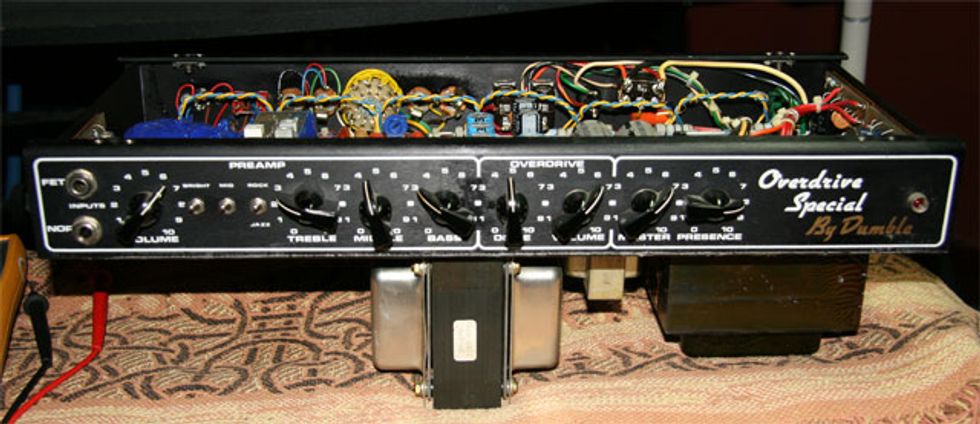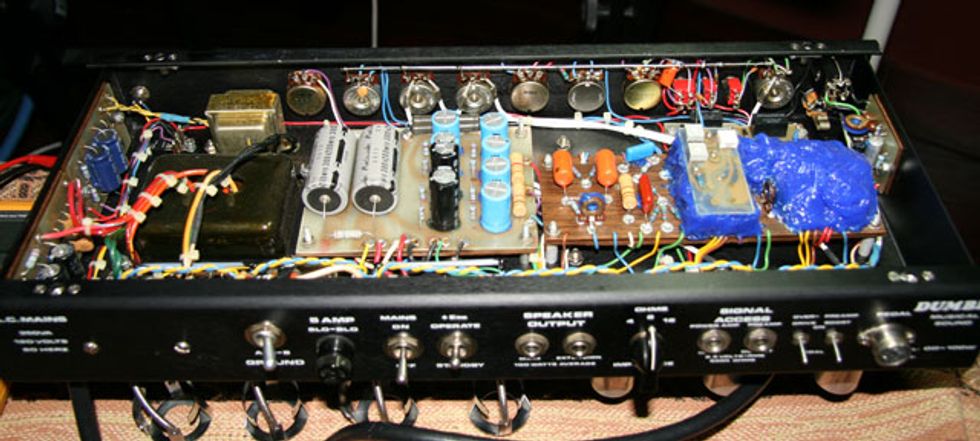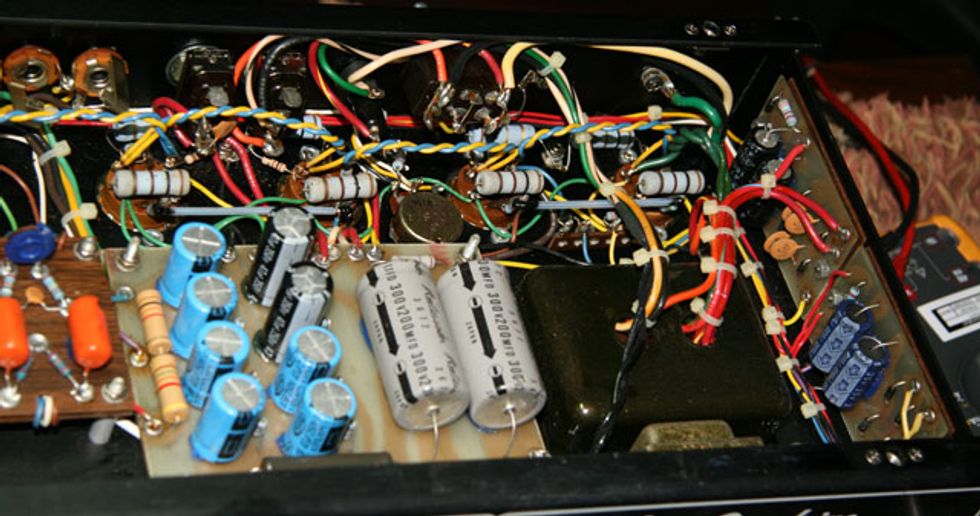Two months ago, we took a peek at a Dumble ODR amplifier and traced its lineage back a couple of decades. This month we will be looking at a Dumble Overdrive Special, which is owned by the same client. This too has been in our shop for the occasional feeding of tubes and has proven to be a very versatile and interesting specimen in its own right.
As with the first article on this subject, the following observations are not intended as an in-depth technical study of circuits employed, as there is simply not enough room to do so. It is intended instead as a point of interest for folks who are fans of interesting or unique amplifiers in general.
The Dumble name has become synonymous with the Overdrive Special model. Many of his designs were tweaked and customized for the intended player, though a couple of runs of similar amps were made for the retail market (albeit in small numbers). This amplifier was made for one of these small runs during the mid ‘90s. It was my understanding that this amp was from a run of 40 Overdrive Specials utilizing what is commonly referred to as the “Skyline” preamp, most being made with a EL34 output section. However, upon further investigation, we find that there is once again a surprise or two underneath the hood.
With the chassis out of the box, we find a couple of differences from what we expected. First of all, instead of the more commonly found 6L6 power tube compliment we would expect to find in most Dumble ODS amps, there is a quartet of EL34s. Some of the phase inverter/drive circuit values are quite different as well, including the feedback resistor. The values have no doubt been changed to adjust for the use of the EL34s. The screen grid resistors are 1K instead of the typical 470ohm, also falling in line with the EL34s. However, the preamp is closer to what is commonly referred to in internet forums as the “Bluesmaster.” Further study into the tone stack and preamp wouldn’t be possible as most of the pre has been “gooped” and therefore hidden from our prying eyes.
(For the uninitiated, gooping is when a builder has created an opaque barrier to hide his/her work (usually with epoxy or silicon). With so many great designs being copied and with the explosion of “clones” this has unfortunately become commonplace out of necessity.)
These differences make this amplifier a unique and desirable piece indeed! Sonny Landreth and Robben Ford are among the higher profile players that use 6L6 version of the “Bluesmaster” based amps.
This is what the owner has to say about using the amplifier:
“I couldn't get the feel of the overdrive channel on this Skyline without the mid boost on. After about ten years, I read online that most players use this model either clean, clean/mid-boost, or OD/mid-boost, never OD channel without mid-boost. I asked Dumble about this, and he said that was indeed the case, but did not explain why it is set up that way. I began playing it much more when I discovered I was using it correctly, messed with settings more, and got much more out of it. These amps are a continuing learning experience, technically and artistically. They are tools of endless depth.After examining and photographing the amp, I found myself at Hillshire Recording studios where both of the Dumble amps we’ve discussed were and the house engineer was on staff. We had a little down time, and decided to lay down some tracks showcasing the two amplifiers using both single-coil and humbuckers-equipped guitars with different channels engaged. The guitarist is Robert Vicks of Chicago, playing a Tom Anderson Classic Strat-Style and a Hamer with a Fralin humbucker in the neck and Lollar humbucker in the bridge.
“It has Bassman-like touch sensitivity on the clean channel with mid-boost. Mid-boost increases volume of the of the clean channel dramatically, and is punchier than earlier Dumbles—more Marshall—while the unboosted clean remains very high headroom Fender, even with the EL34s. I have about all the gain I ever need with the mid-boosted clean channel, with either single-coils or humbuckers, and use the OD channel only if I need more volume control of OD, on the quieter side. If I was gigging with it, I am thinking perhaps OD channel for power chord backups, switch to clean with mid-boost for leads, which is a purer tone to my ear, and punchier.”
Clip 1: Dumble OD-100WR, clean blues riffs without reverb then with Reverb on, using Tom Anderson Classic.
Clip 2: Dumble OD-100WR, dirty blues riffs without reverb then with reverb on, using Tom Anderson Classic.
Clip 3: Dumble Overdrive Special, jazzy clean riffs on channel 1, second half with mid boost on, using Hamer.
Clip 4: Dumble Overdrive Special, dirty blues riffs with mid boost on channel 2, using Hamer.
Clip 5: Dumble Overdrive Special, dirty blues riffs, mid boost on, first with channel 1, then channel 2, using Tom Anderson Classic.
It is always a pleasure checking out other builders’ work. Many are friends of mine, some acquaintances. An exchange of ideas, concepts, problems and challenges keeps my work fresh and interesting day after day.
 Tim Schroeder is the President and chief engineer at Schroeder Audio Inc. of Chicago Illinois where he is responsible for new product design/construction as well as over seeing repair operations at Schroeder Guitar and Amplifier Repair. schroederaudioinc.com
Tim Schroeder is the President and chief engineer at Schroeder Audio Inc. of Chicago Illinois where he is responsible for new product design/construction as well as over seeing repair operations at Schroeder Guitar and Amplifier Repair. schroederaudioinc.com













![Rig Rundown: Russian Circles’ Mike Sullivan [2025]](https://www.premierguitar.com/media-library/youtube.jpg?id=62303631&width=1245&height=700&quality=70&coordinates=0%2C0%2C0%2C0)





